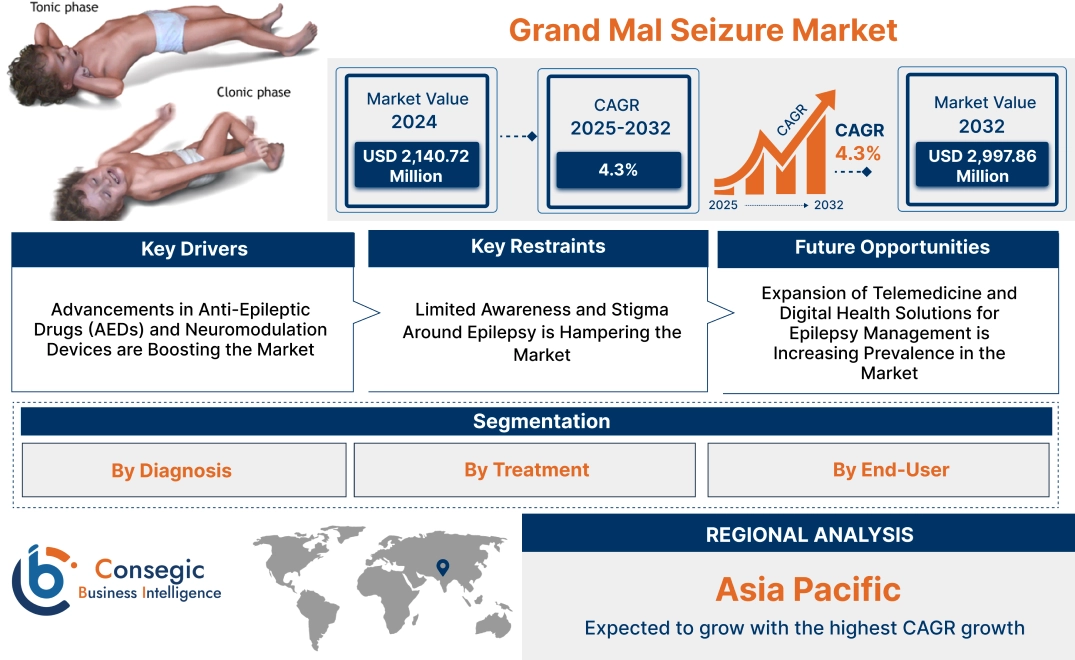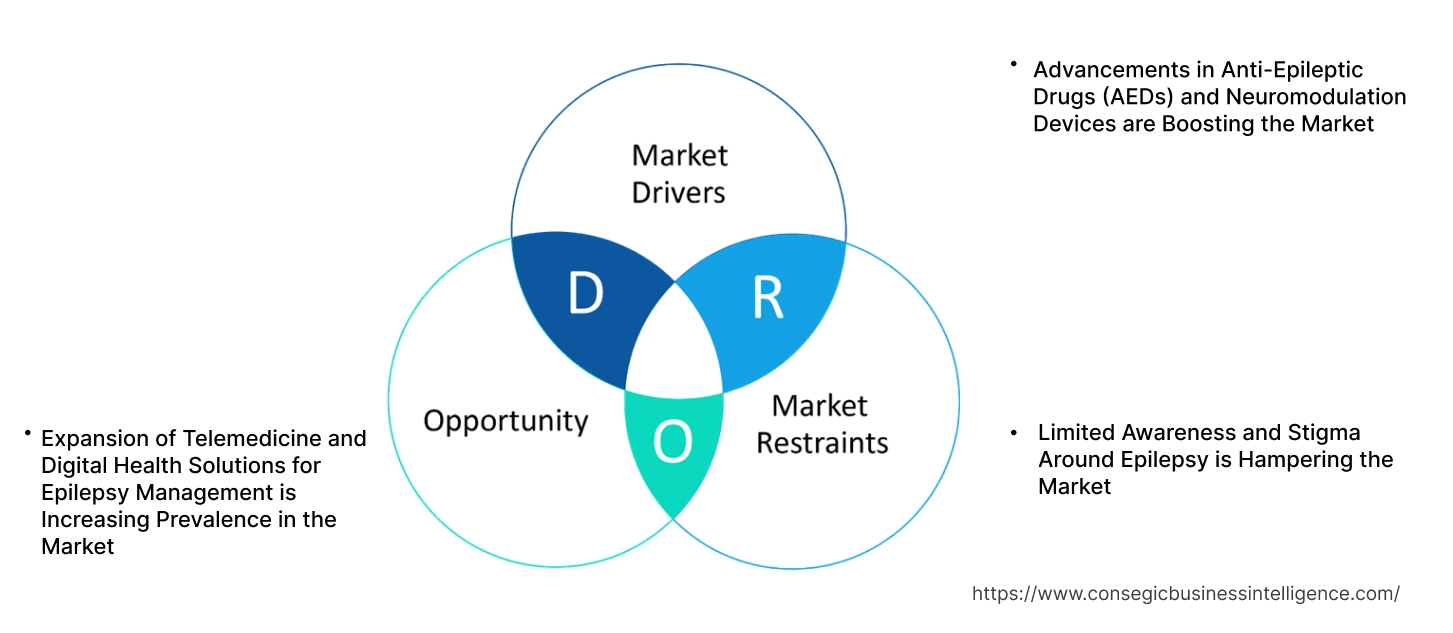- Summary
- Table Of Content
- Methodology
Grand Mal Seizure Market Size:
Grand Mal Seizure Market size is estimated to reach over USD 2,997.86 Million by 2032 from a value of USD 2,140.72 Million in 2024 and is projected to grow by USD 2,194.63 Million in 2025, growing at a CAGR of 4.3% from 2025 to 2032.
Grand Mal Seizure Market Scope & Overview:
The grand mal seizure is generalized tonic-clonic seizures. These seizures involve sudden loss of consciousness and convulsions, often associated with epilepsy and other neurological conditions. The market includes antiepileptic drugs (AEDs), diagnostic tools such as electroencephalograms (EEGs) and imaging systems, as well as supportive therapies like neurostimulation devices. Key characteristics of grand mal seizure management include long-term seizure control, minimization of side effects, and patient-specific treatment plans. The benefits include improved quality of life, reduced seizure frequency, and enhanced safety for patients. Applications span hospitals, neurology clinics, and diagnostic centers. End-users include healthcare providers, neurologists, and caregivers, driven by the increasing prevalence of epilepsy, advancements in seizure monitoring technologies, and growing awareness of early diagnosis and effective treatment options for seizure disorders.
Key Drivers:
Advancements in Anti-Epileptic Drugs (AEDs) and Neuromodulation Devices are Boosting the Market
The management of grand mal seizures has significantly improved with advancements in anti-epileptic drugs (AEDs) and neuromodulation therapies. Modern AEDs are designed to offer better efficacy and reduced side effects, addressing the challenges of traditional treatments. These drugs target specific neural pathways, enhancing seizure control in both newly diagnosed and drug-resistant epilepsy patients.
In parallel, neuromodulation devices such as vagus nerve stimulation (VNS) and responsive neurostimulation (RNS) provide non-invasive options for patients unresponsive to medication. These devices offer precise, targeted intervention by modulating electrical activity in the brain, reducing the frequency and severity of seizures. Trends in precision medicine and patient-centric healthcare continue to drive the development of these innovative therapies, offering enhanced outcomes for patients with grand mal seizures.
Key Restraints:
Limited Awareness and Stigma Around Epilepsy is Hampering the Market
Despite advancements in treatment and diagnosis, epilepsy remains a condition shrouded in stigma and misinformation, particularly in underserved regions. Cultural misconceptions and lack of awareness often lead to delayed diagnosis, inadequate treatment, and social isolation for patients. This not only affects their quality of life but also perpetuates barriers to accessing appropriate care.
Trends in healthcare advocacy and public education campaigns are working to address these challenges by promoting understanding and acceptance of epilepsy. However, sustained efforts are needed to eliminate stigma and improve awareness among both patients and healthcare providers, ensuring timely intervention and comprehensive care for those affected.
Future Opportunities :
Expansion of Telemedicine and Digital Health Solutions for Epilepsy Management is Increasing Prevalence in the Market
The integration of telemedicine and digital health technologies is revolutionizing the management of grand mal seizures. Remote monitoring tools, wearable devices, and mobile health applications enable real-time tracking of seizure activity, empowering patients to manage their condition effectively. These platforms facilitate better communication between patients and healthcare providers, ensuring timely interventions and personalized treatment adjustments.
Trends in digital health adoption highlight the potential of these technologies to improve access to care, particularly in remote or resource-limited settings. Analysis suggests that by leveraging telemedicine and digital health solutions, healthcare providers can enhance epilepsy management, reduce healthcare disparities, and improve outcomes for patients with grand mal seizures.
Grand Mal Seizure Market Segmental Analysis :
By Diagnosis:
Based on diagnosis, the market is segmented into electroencephalogram (EEG), magnetic resonance imaging (MRI), computed tomography (CT) scans, blood tests, neurological exams, and others.
The electroencephalogram (EEG) segment accounted for the largest revenue in the grand mal seizure market share of 34.10% in 2024.
- EEG is a key diagnostic tool for grand mal seizure, which offers real-time brain activity monitoring and aids in seizure localization.
- The non-invasive nature and cost-effectiveness of EEG make it a widely preferred option in hospitals and neurology clinics.
- Technological advancements in portable and wireless EEG systems have enhanced their accessibility in outpatient and home settings.
- Increasing investments in neurology-focused diagnostic tools and growing awareness about seizure disorders are bolstering segment trends.
The MRI segment is anticipated to register the fastest CAGR during the forecast period.
- MRI is increasingly used for detecting structural abnormalities in the brain that may cause seizures, such as tumors or malformations.
- The adoption of advanced MRI techniques, including functional MRI (fMRI), is driving demand for precise and comprehensive diagnostics.
- The rising prevalence trends of epilepsy and the growing focus on personalized treatment plans are boosting the use of MRI in neurology.
- Expanding healthcare infrastructure and access to advanced imaging technologies in emerging markets are further fueling grand mal seizure market opportunities.
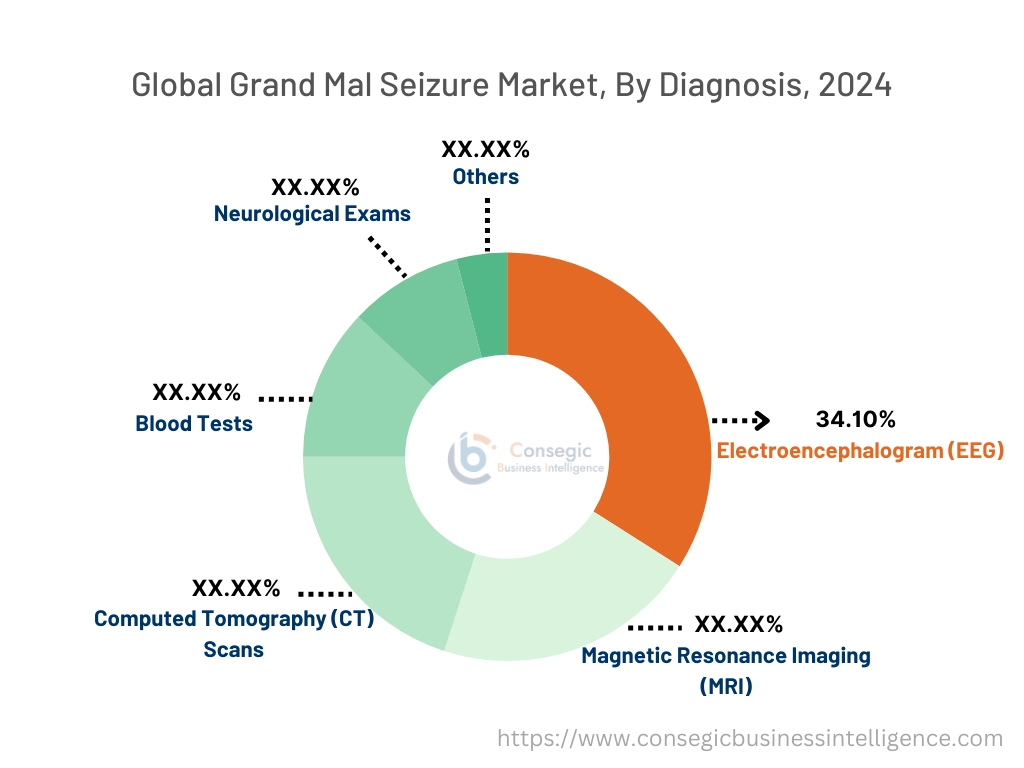
By Treatment:
Based on treatment, the market is segmented into antiepileptic drugs (AEDs), surgery, dietary therapy (ketogenic diet), and supportive care.
The antiepileptic drugs (AEDs) segment accounted for the largest revenue in the grand mal seizure market share in 2024.
- AEDs are the first-line treatment for grand mal seizures, effectively controlling seizures in a significant proportion of patients.
- Common AEDs, such as phenytoin, carbamazepine, and valproate, remain widely used due to their proven efficacy and affordability.
- Increasing availability of newer AEDs, such as lamotrigine and levetiracetam, with fewer side effects is driving their adoption.
- Rising awareness about epilepsy treatment and improved access to medications in both developed and developing regions are supporting this segmental trend.
The surgery segment is anticipated to register the fastest CAGR during the forecast period.
- Surgical interventions, such as temporal lobe resection and vagus nerve stimulation, are increasingly recommended for patients unresponsive to AEDs.
- Advances in minimally invasive neurosurgical techniques have improved patient outcomes and reduced recovery times.
- The rising availability of specialized neurosurgery centers and the growing number of patients with drug-resistant epilepsy are driving growth in this segment.
- Increasing research into novel neuromodulation therapies is expected to further enhance the adoption of surgical treatments.
By End-User:
Based on end-use, the market is segmented into hospitals, specialty neurology clinics, ambulatory surgical centers, and home care settings.
The hospitals segment accounted for the largest revenue share in 2024.
- Hospitals are the primary centers for managing grand mal seizures market trends, providing advanced diagnostic and therapeutic options.
- The availability of skilled neurologists, neurosurgeons, and critical care teams ensures comprehensive care for seizure patients in hospital settings.
- Rising hospital admissions for severe epilepsy cases and the increasing prevalence of drug-resistant seizures are driving grand mal seizure market demand.
- Investments in hospital infrastructure and access to state-of-the-art neurology departments are further supporting grand mal seizure market expansion in this segment.
The specialty neurology clinics segment is anticipated to register the fastest CAGR during the forecast period.
- Specialty neurology clinics are increasingly sought after for personalized seizure care, including advanced diagnostics and treatment plans.
- These clinics cater to patients with complex epilepsy cases, providing tailored approaches to seizure management.
- Growing awareness about specialized care and the availability of outpatient services are driving growth in this segment.
- Expanding networks of neurology clinics in urban and semi-urban areas are expected to further boost grand mal seizure market demand during the forecast period.
Regional Analysis:
The regions covered are North America, Europe, Asia Pacific, the Middle East and Africa, and Latin America.
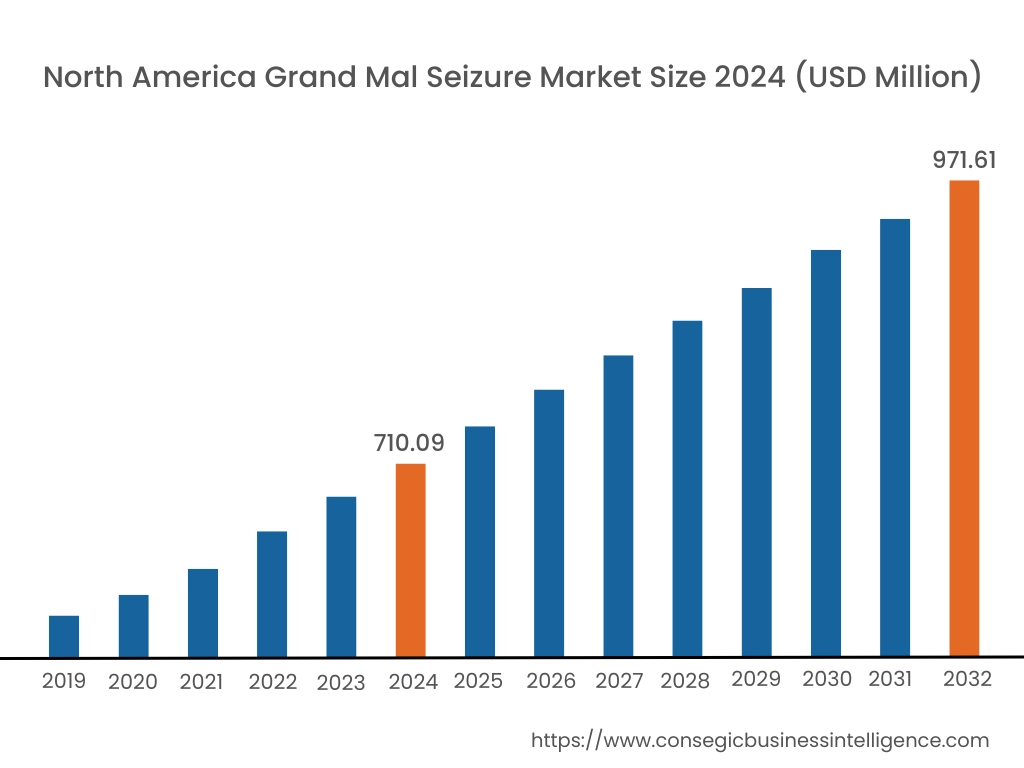
In 2024, North America was valued at USD 710.09 Million and is expected to reach USD 971.61 Million in 2032. In North America, the U.S. accounted for the highest share of 71.60% during the base year of 2024. North America holds a significant share of the grand mal seizure market, driven by the rising prevalence of epilepsy, advancements in neurological diagnostics, and increasing awareness about seizure management. The U.S. leads the region due to a robust healthcare system, widespread adoption of advanced antiepileptic drugs (AEDs), and growing research on epilepsy treatments. As per the grand mal seizure market analysis, Canada contributes by increasing access to healthcare facilities and initiatives promoting early diagnosis and treatment of epilepsy. However, the high cost of advanced treatments and lack of awareness in certain rural areas may limit market growth.
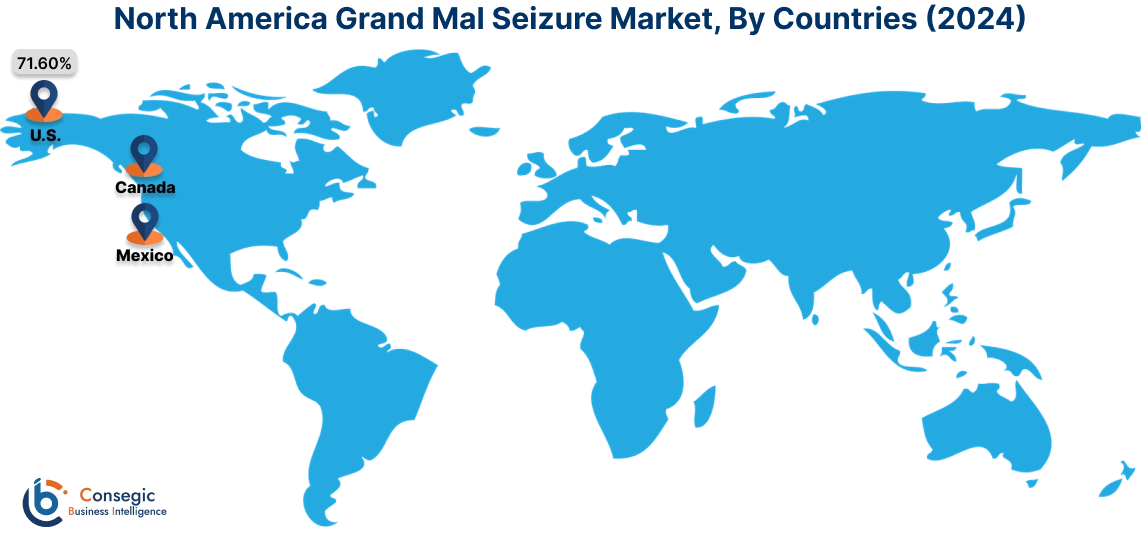
In Asia Pacific, the market is experiencing the fastest growth with a CAGR of 4.7% over the forecast period. The grand mal seizure market analysis is fueled by an increasing prevalence of epilepsy, improving healthcare infrastructure, and rising awareness about seizure disorders in China, India, and Japan. China dominates the market with government-led initiatives to improve epilepsy care, including better access to AEDs and diagnostic tools in rural areas. India’s expanding healthcare sector and increasing focus on affordable treatments for epilepsy drive demand for AEDs and diagnostic technologies. Japan emphasizes advanced treatments such as neuromodulation devices and research on novel epilepsy therapies. However, limited awareness in rural areas and affordability issues may hinder market growth in emerging economies.
Europe is a prominent market for global grand mal seizure treatment, supported by an aging population, a growing prevalence of neurological disorders, and strong government support for epilepsy management programs. Countries like Germany, France, and the UK are key contributors. Germany drives demand through its advanced healthcare infrastructure and focuses on innovative seizure treatments, including neurostimulation therapies. As per the regional analysis, France emphasizes the availability of AEDs and early diagnosis initiatives, while the UK focuses on public awareness campaigns and improving access to specialized epilepsy care. However, budget constraints in public healthcare systems may pose challenges in some parts of the region.
The Middle East & Africa region is witnessing steady growth in the grand mal seizure market trends, driven by increasing healthcare investments and rising awareness about neurological disorders. Countries like Saudi Arabia and the UAE are adopting advanced epilepsy treatments and diagnostic tools to improve seizure management. In Africa, South Africa is an emerging market, focusing on improving access to AEDs and educating healthcare providers on epilepsy care. However, limited healthcare infrastructure and a lack of trained neurologists in many parts of the region may restrict grand mal seizure market expansion.
Latin America is an emerging market for grand mal seizure treatment, with Brazil and Mexico leading the region. Brazil’s growing healthcare sector and increasing prevalence of epilepsy drive demand for AEDs and specialized neurological care. Mexico focuses on improving access to epilepsy treatments and raising public awareness about seizure disorders. The region is also exploring partnerships with international organizations to enhance epilepsy care in underserved areas. However, economic instability and inconsistent healthcare infrastructure may pose challenges to market growth in smaller economies.
Top Key Players and Market Share Insights:
The grand mal seizure market is highly competitive with major players providing products to the national and international markets. Key players are adopting several strategies in research and development (R&D), product innovation, and end-user launches to hold a strong position in the grand mal seizure market. Key players in the grand mal seizure industry include -
- Pfizer Inc. (United States)
- UCB Pharma (Belgium)
- Zydus Cadila (India)
- Sanofi S.A. (France)
- Teva Pharmaceutical Industries Ltd. (Israel)
- GlaxoSmithKline plc (United Kingdom)
- Eisai Co., Ltd. (Japan)
- Novartis AG (Switzerland)
- Johnson & Johnson (United States)
- Sun Pharmaceutical Industries Ltd. (India)
Grand Mal Seizure Market Report Insights :
| Report Attributes | Report Details |
| Study Timeline | 2019-2032 |
| Market Size in 2032 | USD 2,997.86 Million |
| CAGR (2025-2032) | 4.3% |
| By Diagnosis |
|
| By Treatment |
|
| By End-Use |
|
| By Region |
|
| Key Players |
|
| North America | U.S. Canada Mexico |
| Europe | U.K. Germany France Spain Italy Russia Benelux Rest of Europe |
| APAC | China South Korea Japan India Australia ASEAN Rest of Asia-Pacific |
| Middle East and Africa | GCC Turkey South Africa Rest of MEA |
| LATAM | Brazil Argentina Chile Rest of LATAM |
| Report Coverage |
|
Key Questions Answered in the Report
What is the projected market size of the Grand Mal Seizure Market by 2032? +
Grand Mal Seizure Market size is estimated to reach over USD 2,997.86 Million by 2032 from a value of USD 2,140.72 Million in 2024 and is projected to grow by USD 2,194.63 Million in 2025, growing at a CAGR of 4.3% from 2025 to 2032.
What factors are driving the Grand Mal Seizure Market? +
Key drivers include advancements in anti-epileptic drugs (AEDs), increasing adoption of neuromodulation devices, and rising awareness of seizure management and early diagnosis globally.
What are the challenges faced by the market? +
Challenges include limited awareness about epilepsy, societal stigma, and inadequate access to advanced treatments in resource-constrained regions.
Which diagnostic tool dominates the market? +
Electroencephalogram (EEG) dominates the diagnostic segment due to its ability to monitor real-time brain activity, aiding in the accurate diagnosis of seizures.
Which treatment option holds the largest market share? +
Anti-epileptic drugs (AEDs) hold the largest share, being the first-line treatment for controlling grand mal seizures effectively.
